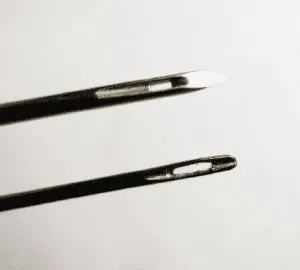
2. Needle eye dimensions can vary widely. The stitching palm needle (bottom) is smaller than the Awl-for-All needle, but its eye is actually bigger.

3. The stitching awl needle wider to allow for the thread groove and the occasional misaligned push, resulting in a bigger hole and torn fibers in the cloth.

4. The locking stitch of a stitching awl does not truly lock. It resists pulling out slightly better than single pass hand stitching, but not enough for you to go running out to buy a stitching awl. For real security, use a saddle stitch.

5. The needle and palm holes are smaller, tight and there is less damage to the sail fibers than with the stitching awl.

6. The light leaking through holes created by the stitching awl clearly show how the stitching awl does more harm to the material than hand stitching using a sailor’s palm and a correctly sized needle and thread. For hand-sewn sail repairs,#8 metric twine with a matching needle are commonly used. For hand-sewn whipping or stitching ropes or webbing, #12 metric twin is common.





































